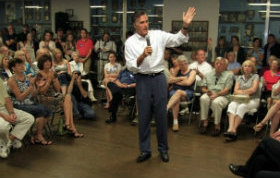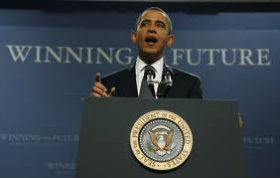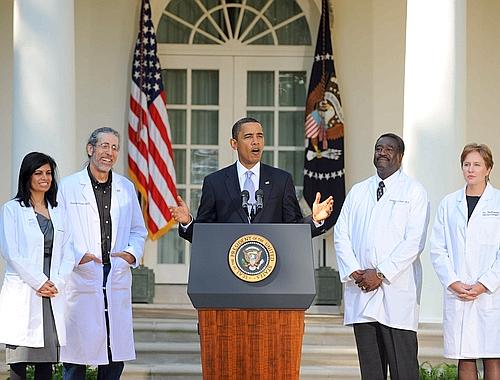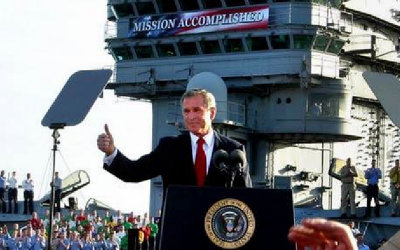Visual Literacy & Politics
Politicians Are Manipulating What You See in the News
“We have a far more sophisticated audience today than in the past, one that sees more clearly behind the manipulations and stagecraft of its political leaders.” ~ Alissa Quart, media watcher, quoted in The Sarcastic Times
Watch out: you’re about to be manipulated—if you aren’t careful.
The political arena has borrowed the words “stagecraft” and “choreography” from the world of theatre. Stagecraft refers to the work of directors who arrange the elements of what is seen so that a coherent message is communicated and understood by the audience. Nowhere is stagecraft more at play than in today’s image-driven world of politics.
At the highest levels of politics, hundreds of people are routinely employed to manage everything from what a candidate wears, to what colors and symbols participants see, to what music they hear, to what people appear in the background.
Stagecraft is in play not only during election seasons, but also every day, especially when the President goes out on the road during a speaking engagement.
The manipulators know that to be in charge of the image is to control what the audience sees, hears and understands: show them the good stuff and make it look both upbeat and appealing. It’s a lot like commercial advertising, which puts carefully groomed products under the lights so they look polished and bright.
Ronald Reagan famously stuck his head into a room where admen were crafting one of his re-election commercials and reportedly declared: “Since you’re the ones who are selling the soap, I thought you’d like to see the bar.” (Source)
Yes, candidates are like products: today they are packaged and sold just like cars and trucks, via television commercials with high production values. Everybody does it. it’s a far cry from 1956, when Adlai Stevenson thought such marketing was undignified and refused the adman’s treatment. Of course, he lost the election to Dwight Eisenhower.
Josh King, a former White House image manipulator, takes credit for creating the word “polioptics” to describe how important it is to control the image in today’s media world. Polioptics comes into play in almost every presidential event, from giving a speech at a podium to kissing the baby at an election rally. (King now co-hosts a talk show about political image persuasion on the SiriusXM Satellite radio POTUS channel.)
Visual literacy is a critical 21st century skill
In a book I authored about the role of mass media in politics, I made note of the various ways presidents have used the media, and how media organizations cover elections. Standards for visual literacy emphasize the need for all of us to become more aware of how media messages are created, and sometimes staged, and how important it is to “read” what is happening (and what is not) in an image or video production.
Here is an example: President Obama is surrounded by what appear to be doctors at a Rose Garden ceremony concerning passage of the Health Care Act.
How do we know they are doctors? They’re wearing those white lab coats. Did they arrive at the White House wearing those coats, or did the White House distribute them? We don’t know; we weren’t there to witness this event and few members of the media reported on the white coats. News consumers depend upon journalists, including photojournalists, to document and report on news events. All too often they just snap the picture. (In this particular case, the White House invitation to the physicians requested they wear a white lab coat. But, in one news story critical of this photo-op, a New York newspaper published a photo of a White House staffer handing a coat to a doctor who neglected to bring his own.)
So, we might ask our students, what do you think the White House was trying to communicate via this image?
The Roots of Political Stagecraft: Some brief history
Photography was a new invention when Abraham Lincoln ran for president. Yet, the Man from Illinois posed in Mathew Brady’s photographic studio several times. Brady knew how to make Lincoln look good: he raised Lincoln’s shirt collar in order to de-emphasize the candidate’s neck. That early photo shoot produced several Brady images of “Honest Abe” that some say helped get him elected.
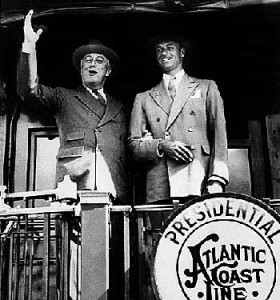
It was Richard Nixon who created the White House Office of Communications. His first hire was Roger Ailes, who now heads Fox News. Today that office is occupied by former advertising, news and television experts—all of whom know how to craft a message and use the media to their advantage.
But it was during Ronald Reagan’s time in office that presidential-level political stagecraft began to be noticed. Reagan’s chief image-maker was Michael Deaver whose mantra was “image trumps words.” Nancy Reagan said Deaver’s greatest skill was “arranging what were known as good visuals — televised events or scenes that would leave a powerful symbolic image in people’s minds.” (Source: “Longtime Reagan Adviser Michael Deaver Dies From Cancer”. Fox News. August 19, 2007)
Deaver recalled the time Reagan campaigned in California at a B-1 Bomber assembly plant facing huge layoffs. Deaver, wanting to counter the idea that Reagan was a hawk, managed to have the plane, strategically placed behind the president’s podium, draped with a banner that declared “Prepared for Peace.” With the White House dictating where all of the cameras would be positioned, the media all got the same shot: Reagan in the foreground, with the word “Peace” clearly visible in the background.
Frame grab from American Photography: A Century of Images (video series)
When President Bush declared (prematurely) that major combat operations in Iraq had ended, with the huge “Mission Accomplished” banner hanging behind him, it was decided that the president should speak just as the sun was setting—creating what photographers call the “golden hour” just before sunset. Thus no TV lights had to be used—Mother Nature would provide the best lighting.
Today, when President Obama goes out on the road to speak, the background most often includes an audience especially selected by the White House Office of Communications to represent an ethnically and gender diverse group.
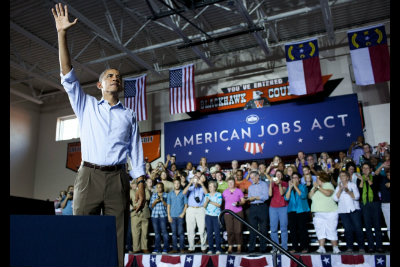
President Barack Obama at West Wilkes High School in Millers Creek, N.C. (Official White House Photo by Pete Souza)
Sometimes, the stagecraft backfires. When presumptive GOP presidential nominee Mitt Romney delivered a major economic speech in Detroit in February 2012, the location was Detroit’s Ford Field, home of the pro football Lions.
But some in the media observed that the stadium was empty and the 1200 people in attendance actually appeared smaller when seen from the perspective of the 80-thousand seat arena.
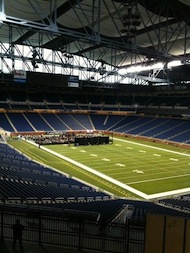
Ideas for the Classroom
The opportunities to teach about political and visual stagecraft are abundant, to say the least.
• Ask students to locate and select a photo from the website of a candidate running for local, regional or national office. For example, a Romney tumblr page or Obama’s current page. (If students cannot locate photos there, they should look for images on the web sites of local newspapers or political blogs that cover candidates and elections. If they use Google Images, be sure to have them follow the image to its source.) Students can work in groups, with each group analyzing one photo, or students can choose a photo to analyze individually.
• Since many students won’t have had any prior experience in “reading” a photo, print out and distribute this “Photo Analysis Worksheet” created by the National Archives. Give students time to complete the worksheet and then have them present their findings and observations to the entire class.
• Have students compare examples of commercial product placement and political candidate/message placement.
• If possible, invite a photojournalist into your class (live or via Skype) to discuss the challenges of covering a candidate on a daily basis.
For more about visual literacy, see the resources collected on the Media Literacy Clearinghouse website. Find more about the role of media in politics at my website.
Images: For image source, click on the image.
Frank W. Baker is a much sought-after media literacy education consultant. He is the author of three books; his most recent is Media Literacy In The K-12 Classroom (ISTE, 2012). He maintains the nationally recognized Media Literacy Clearinghouse website and he conducts media literacy workshops at schools and districts across the US. He is a consultant to the National Council of Teachers of English (NCTE). He can be reached at fbaker1346@aol.com.


